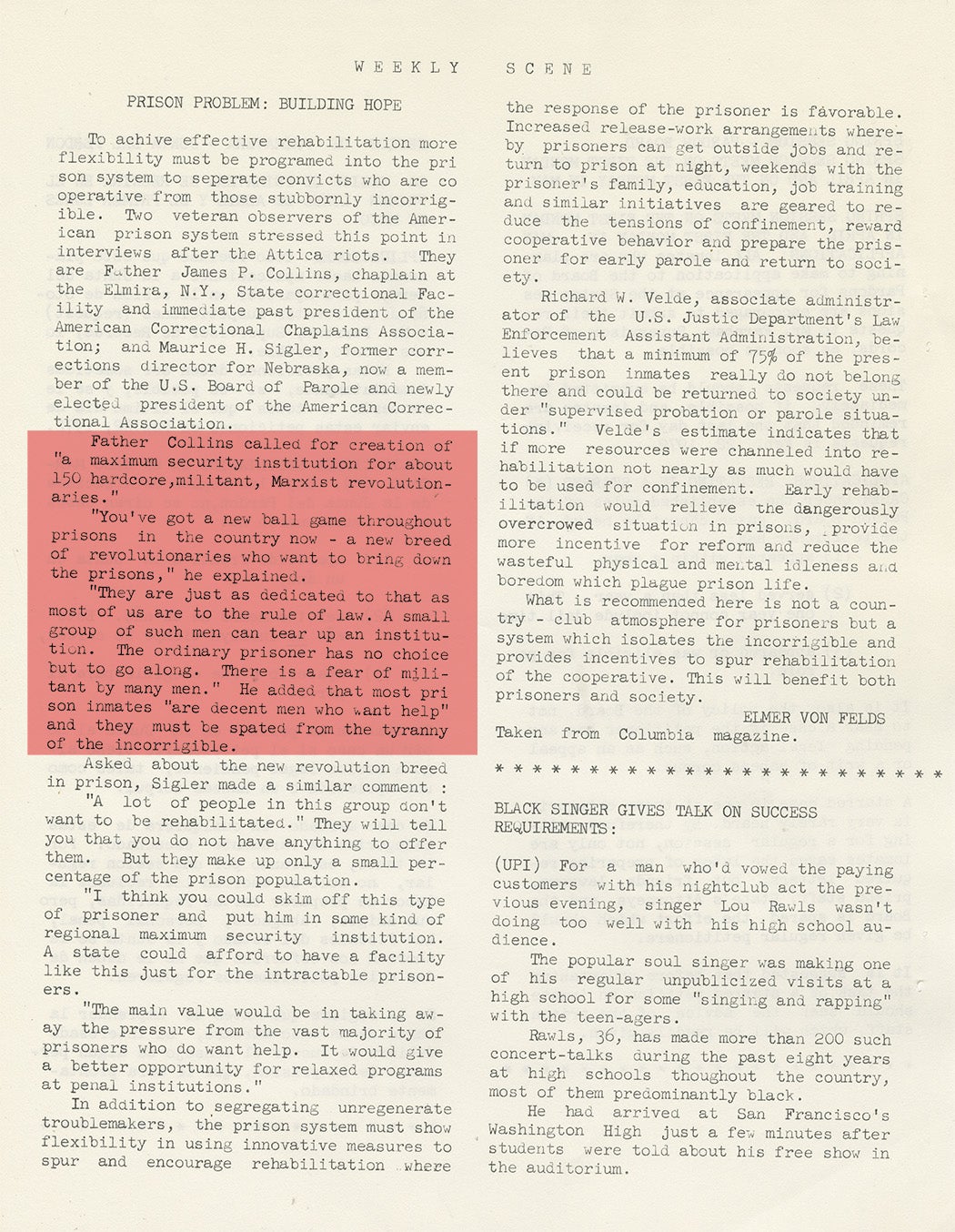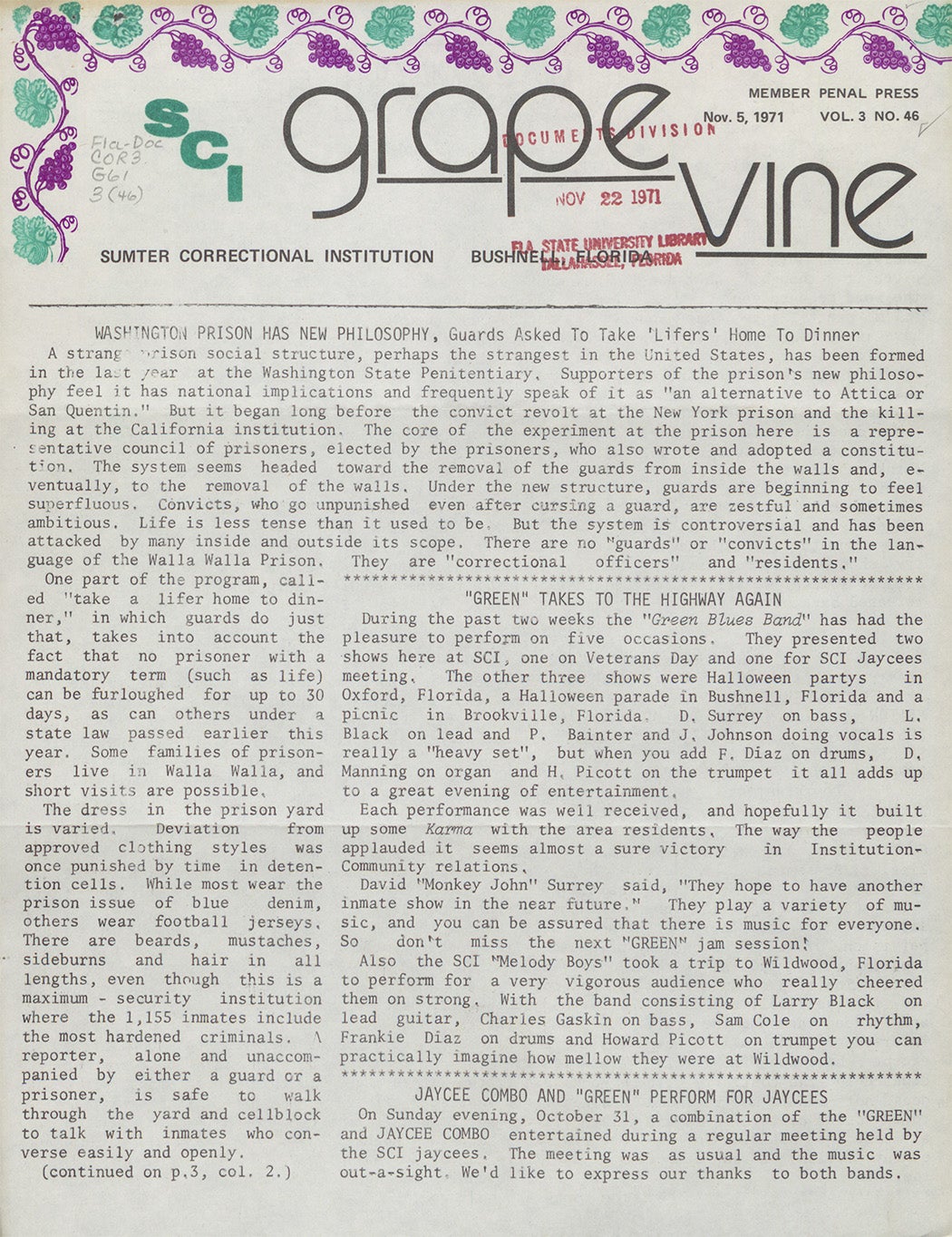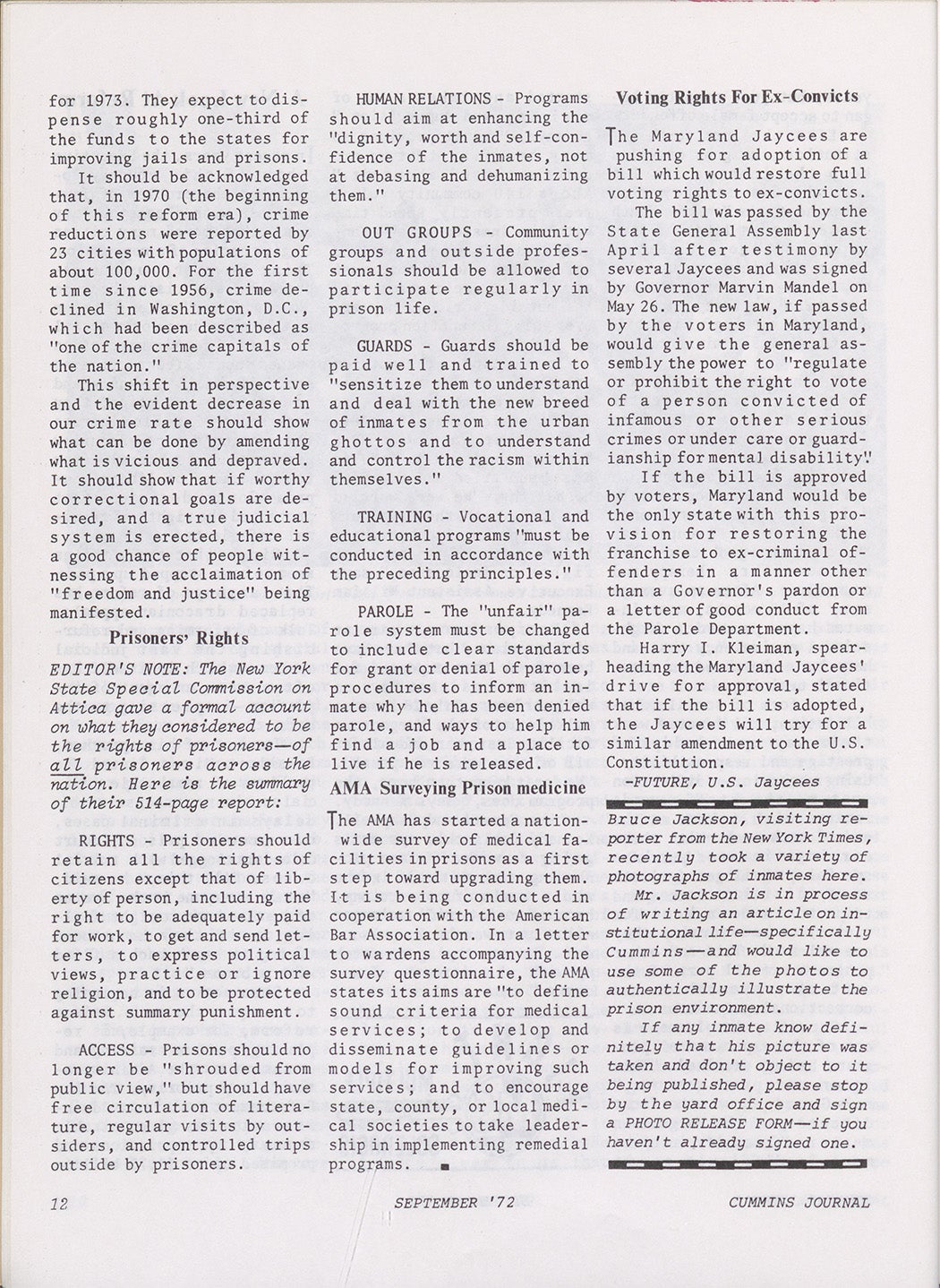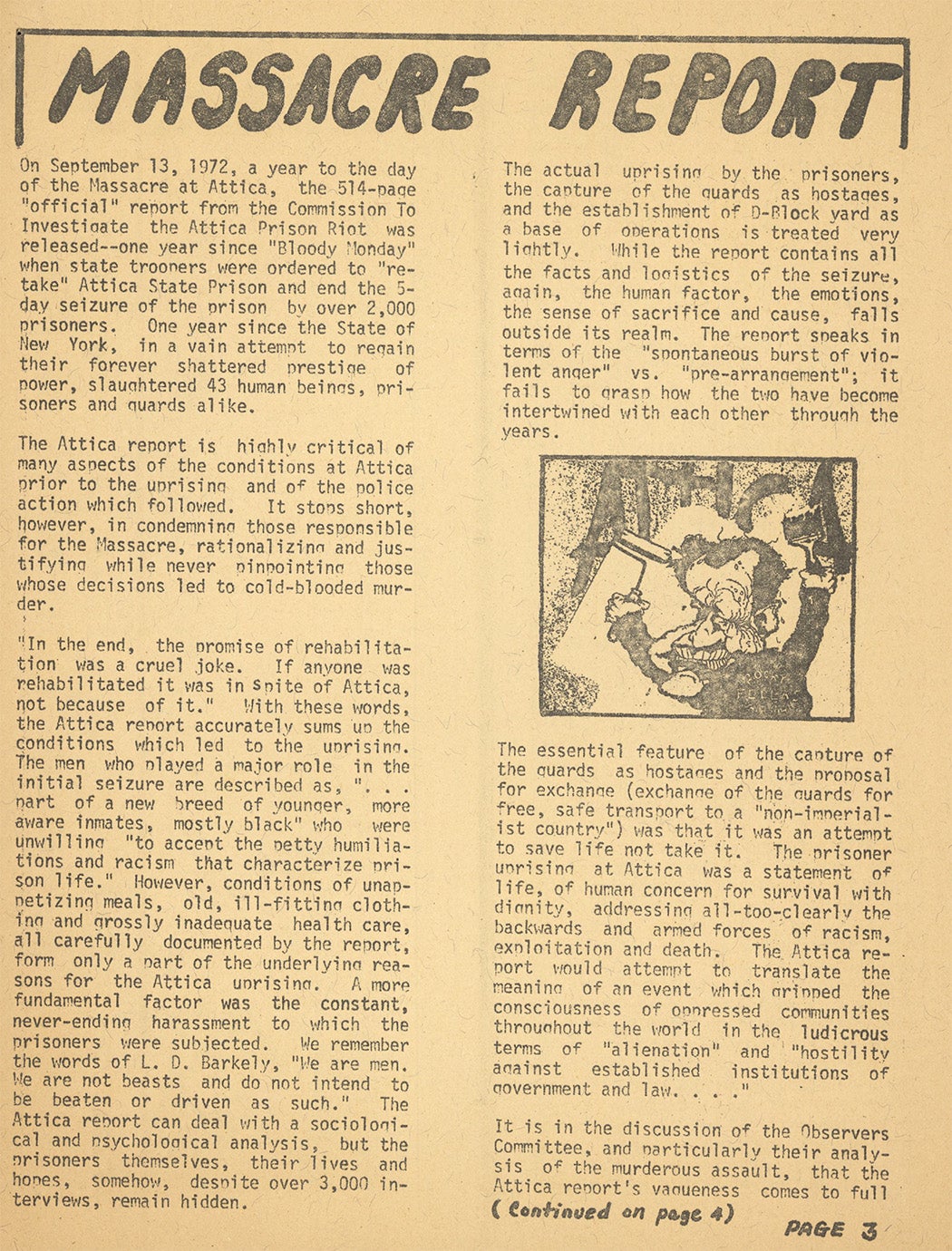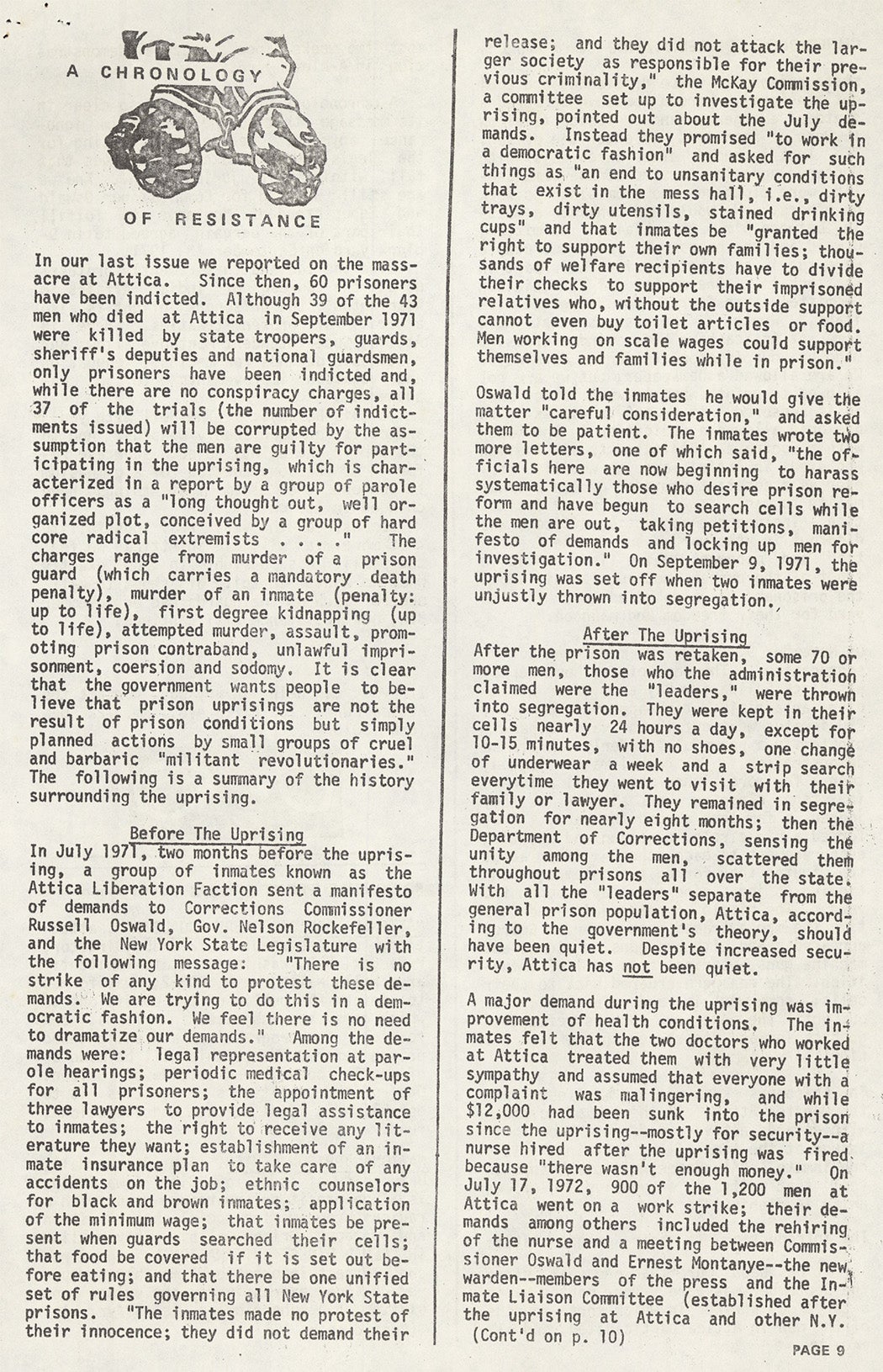In September 1971, law enforcement stormed New York’s Attica Correctional Facility and opened fire on prisoners who had taken 38 guards hostage to demand basic human rights, including access to healthcare. State authorities killed 29 incarcerated people and 10 correctional officers in the process. Six weeks later, the governor of New York called for a Special Grand Jury investigation into the uprising.
Within a month of the takeover and subsequent massacre (as it was called in the Pa’aho Press), the prison press began circulating commentaries on what happened at Attica. The often-controversial subject remained a frequent topic in the penal press. People opined on many facets of the crisis, the McKay Commission’s official investigation, and finally their report, which spawned even more commentary from incarcerated voices. Via Reveal Digital’s American Prison Newspapers collection, contemporaneous accounts from incarcerated writers are now available online open access.
To investigate the mass casualty event, the state appointed a Special Deputy Attorney General who formed the Attica Task Force. By November the governor had appointed a special commission on Attica, chaired by NYU Law School Dean Robert B. McKay. The McKay Commission investigated the events that lead up to and transpired during and after the uprising, producing a 514-page report about it the next year.
References to Attica in the Penal Press, September 1971 – September 1972
Prisoners wrote about both major media and penal press coverage of the uprising at the New York prison. What’s Up, an Avon Park Correctional Institution publication out of Florida, featured an article in their October 1, 1971, issue about formerly incarcerated activist Joe Grant starting the International Penal Digest for prisoners and former prisoners. The unnamed author contrasted Grant’s perspective with the attention Attica received from “mostly uninformed writers” sharing views in the media that were “slanted by their shallow understanding and prejudices.”
In the October 1971 issue of the Oklahoma State Penitentiary’s The Eye Opener, contributor Joe Carnes made a statement “TO THE PENAL PRESS,” acknowledging “an absence of any discussion about the Attica thing,” because the editors and writers “feel that it is too hot an item to touch at this time,” and because “the news media has said it much stronger than we would ever dare.”
Members of the penal press reprinted some of those indicting articles about Attica from legacy newspapers as well. In a piece called, “COMMENTARY ON PRISONS,” featured in the July 1972 issue of What’s Up and originally published by ABC News in September 1971. Howard K. Smith, the writer of the ABC piece, explicitly suggests there’s “something wrong with our prisons,” and that “it takes far gone despair for prisoners to try what they tried in Attica, or in San Quentin” [—where guards assassinated the activist and writer George Jackson in August of 1971, broadly understood to be a precipitating event to Attica—] “or in the Tombs in New York, or in prison after prison before that.” The era was fraught with prison uprisings and, for the first time, the US experienced a growing national consciousness that the uprisings belied problems not with the prisoners themselves but with the prisons to which they were confined.
“Our underfunded prisons,” Howard Smith wrote for ABC, “devote 95 percent of their resources to preventing prisoners from having [community ties] —to custody, to incarceration, to guarding him. Only 5 percent of funds go to education, to training, to experimentation with limited freedom—the kinds of things that create ties and roots.” Baked into the ABC News correspondent’s analysis is that if prisons had more money, they would fund more rehabilitation-focused initiatives—reducing the need for prisons altogether—a notion that would prove false in coming decades as prison budgets soared but rehabilitative efforts dwindled.
As events at Attica focused public attention on the lack of healthcare inside prisons in the US in the early 1970s, Castle, a Kentucky State Penitentiary publication, devoted two full pages in the June/July 1972 issue of the paper to reprinting a piece, “MEDICAL UN-CARE FOR PRISONERS.” In the piece, Dr. Frank Rundle, who previously worked as the chief psychiatrist at Soledad Prison, claims to have been fired because he put the medical needs of prisoners above the needs of the institution.
Ominously, Rundle translated the anxiety after the Attica uprising into a forecast for the future:
[S]o long as prisons as presently constituted exist, in which a man’s life is almost totally controlled by the state, his total helplessness in seeking medical care must be considered and reasonable efforts made to provide decent levels of medical care. … If this is not done, a problem area which has contributed to violence and death at Soledad, San Quentin and Attica will continue to smoulder [sic]- – – – and bring further destruction of life within prisons.
Prison administrations shared his fears, and contributors to prisoner newspapers, understanding what was at stake, paid attention. The January 22, 1972, issue of The Weekly Scene includes an article reprinted from Columbia magazine with comments from a chaplain at the correctional facility in Elmira, New York, and the president of the American Correctional Association. Both called for separation of cooperative and recalcitrant prisoners “after the Attica riots,” and the chaplain championed the establishment of “a maximum security institution for about 150 hardcore, militant, Marxist revolutionaries.” Though wildly divergent, it was a time of strong opinions around how to modify the nation’s approach to incarceration.
Interest in Unconventional Paradigms of Justice
Interest in different approaches to justice and incarceration surged around the time Attica exploded. With the implementation of a different system at the Washington State Penitentiary in Walla Walla, where prisoners were granted authority to govern themselves, juxtaposition with Attica became common in the pages of prisoner papers .
Although a guest editorial that appeared in Best Scene a few months later tempered enthusiasm for the program—mistakes within the justice system, “whether too bad as in Attica, or ‘too good’ as in Walla Walla,” can elicit the ire of an entire country—the penal press nevertheless noticed Walla Walla’s promise, framing it as an alternative to the suffering Attica wrought.
A contribution to the April 1972 issue of Cummins Journal, disseminated by prisoners of the Arkansas Department of Corrections, reprinted from a prisoner paper in Rhode Island, quoted the incarcerated council president at Walla Walla, Johnnie Harris, who suggested, “If self-government hadn’t come when it did, we would have had another Attica, or San Quentin, or Soledad.”
A reporter wrote in the November 1971 issue of the Grapevine newspaper, printed out of the Sumter Correctional Institution in Bushnell, Florida, that the new system empowers a council of incarcerated persons elected by other prisoners to make institutional decisions and “seems headed toward the removal of the guards from inside the walls and, eventually, to the removal of the walls,” alluding to aims of prison abolition, a movement that gained steam during that decade.
After the McKay Commission Report
By September 1972, the McKay Commission had released its report on Attica. In an issue of the Cummins Journal, released the same month, an editor’s note explained prisoners there had published a summary of the 514-page report produced by the New York State Special Commission on Attica. The summary included direct quotes from the Commission regarding prisoner rights, a number of which weren’t recognized before or after Attica. “Prisoners should retain all rights except that of liberty of person,” reads the summary, “including the right to be adequately paid for work, to get and send letters, to express political views, practice or ignore religion, and to be protected against summary punishment.”
Come December 1972, the Pa’ahao Press, a Hawaiian prison newspaper that predates statehood there, featured a piece titled, “MASSACRE REPORT”:
On September 13, 1972, a year to the day of the Massacre at Attica, the 514-page official report from the Commission To Investigate the Attica Prison Riot was released—one year since ‘Bloody Monday’ when state troopers were ordered to ‘retake’ Attica State Prison and end the 5-day seizure of the prison by over 2,000 prisoners. One year since the State of New York slaughtered 43 human beings, prisoners and guards alike.
The penal press analysis of the McKay Commission’s findings pointed out the Commission’s harsh criticism of conditions at Attica leading up to the uprising, and even to the report’s repudiation of gratuitous state violence. The Pa’ahao Press contributor also took the Commission to task for the “poor whitewash” of state terror and for its failure to convey the human dimension of the prisoners’ struggle.
While the Commission’s report may have grazed at the edges of the violence committed by the state, it “stops short, however, in condemning those responsible for the Massacre, rationalizing and justifying while never pinpointing those whose decisions led to cold-blooded murder.” The writer noted that the Commission concluded, correctly, that “the use of shotguns not only increased the risk but virtually assured the death or serious injury of innocent persons in the contested confines of D-yard.”
But the writer was critical of how the report treated the rebellion. “The actual uprising by the prisoners, the capture of the guards as hostages, and the establishment of D-Block yard as a base of operations is treated very lightly,” the Pa’ahao Press explained. “While the report contains all the facts and logistics of the seizure, again, the human factor, the emotions, the sense of sacrifice and cause, falls outside its realm.”
Interpreting events from an incarcerated perspective, the contributor claimed the rationale behind “the capture of the guards as hostages and the proposals for exchange (exchange of the guards for free, safe transport to a ‘non-imperialist country’) was that it was an attempt to save life not take it. The prisoner uprising at Attica was a statement of life, of human concern for survival with dignity, addressing all-too-clearly the backwards and armed forces of racism, exploitation and death.”
“One year later,” the incarcerated intellectual surmised, “the memory of Attica lingers.” Indeed, “while the dead have been buried and the Massacre etched into our troubled history, the spirit of Attica, of faith, dedication and struggle remains”—or, it at least continued to course through the corridors and cell blocks where human beings remain confined.
The Pa’ahao Press ran a thorough history of Attica-related events up that point—“A Chronology of Resistance”—in their February 1973 issue (incorrectly dated 1972). The author mentions 60 prisoners—and no authorities—had been indicted thus far in connection with the uprising, despite the fact “39 of the 43 men who died at Attica in September 1971 were killed by state troopers, guards, sheriff’s deputies and national guardsmen.” As the unnamed author recounted, the administration threw some 70 prisoners, suspected of being “leaders” during the revolt into segregation for almost eight months, confining each in a cell nearly 24 hours per day without shoes and with just one change of underwear per week.
The chronology cites the McKay Commission report, which stated prisoners who organized the rebellion committed “to work in a democratic fashion” with the administration to realize fundamental changes, like “an end to unsanitary conditions that exist in the mess hall” —an issue still relevant on the inside today. The Commission’s report, per the Pa’ahao Press history, stated incarcerated persons ought to be “granted the right to support their own families” with living wages. In 2022, some states do not offer even nominal wages to prisoners—slavery as punishment, à la the Thirteenth Amendment—with others paying pennies per hour.
Despite demands for better healthcare being a central impetus behind the uprising, less than a year later the healthcare situation at Attica was still a source of tension. In July of 1972, 900 men reportedly went on a work strike to demand “the rehiring of the nurse and a meeting between Commissioner Oswald and Ernest Montanye—the new warden—members of the press and the Inmate Liaison Committee…” Again, they were taking drastic measures trying to force adequate care.
Montanye refused to permit attorneys or media to enter during the three-day lock-in, and authorities put at least two men in segregation for participating. Then, on Black Solidarity Day, November 8, 1972, about 250 prisoners engaged in a celebratory protest in the yard. Clearly disregarding the recommendations of the McKay commission, guards showed up in “vests full of ammunition” with gas guns, shotguns, machine guns in hand, and officers threw 100 men in segregation for the incident the next day, according to the newspaper’s history.
Later that month, prisoners produced their “Manifesto from the Monster Attica,” which reiterated demands similar to those issued the year before, evidently unanswered and unaddressed in light of the state Commission’s report. “Here in Attica, Superintendent Montanye allows our most basic demands for medical, education and vocation improvements to go unanswered,” pointing instead to a newly built gymnasium as proof the place has changed, according to a scathing critique republished in the Pa’ahao Press.
Weekly Newsletter
The paper published several paragraphs from the November 1972 manifesto, including comments that its authors in Attica were “still waiting for the legislature to make the changes that fall within their jurisdiction,” and “still waiting for Commissioner Oswald and Superintendent Montanye to fulfill their part of the bargain agreed to in D-block yard on September 13, 1971.”
The piece reprinted a harrowing vow from the November 1972 demands, “our resistance will continue”,” a promise kept not only by veteran organizers at Attica, but also by prisoners elsewhere who wrote and read about their work via the newspapers circulating inside. Recently, when resistance resurfaced with a prisoner strike in Alabama, those involved proclaimed, “We are human beings,” harkening back to the cry of Attica prisoners circa 1971, “We are men.” More than fifty years later, the humanity of incarcerated people needs to be asserted.
Support JSTOR Daily! Join our new membership program on Patreon today.
